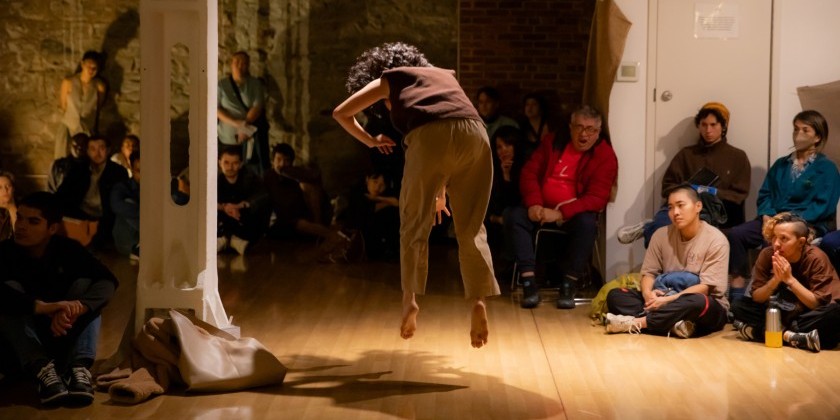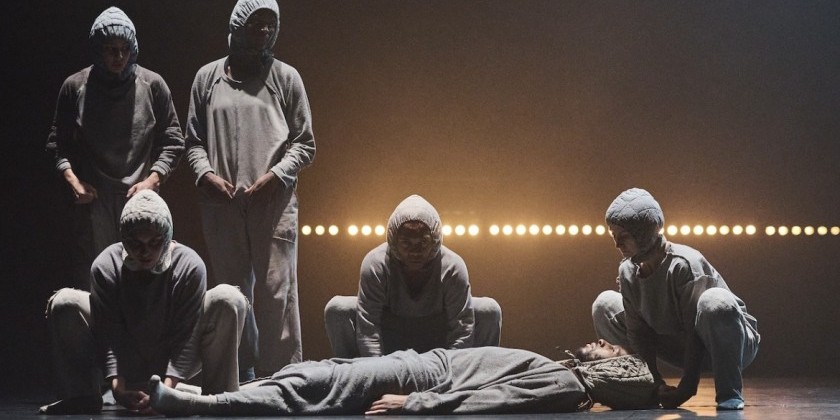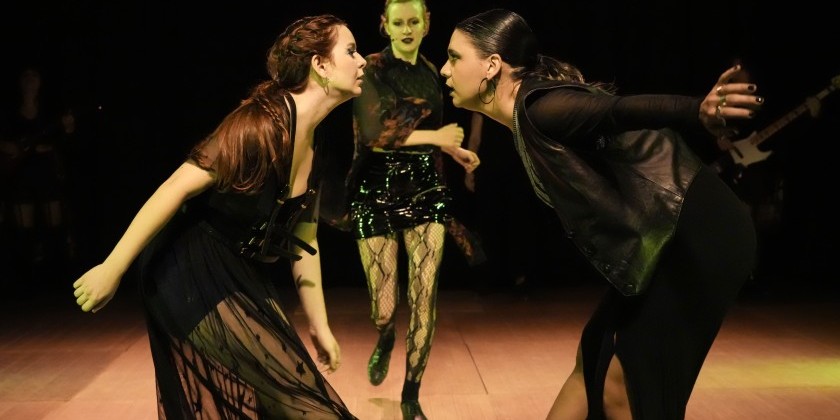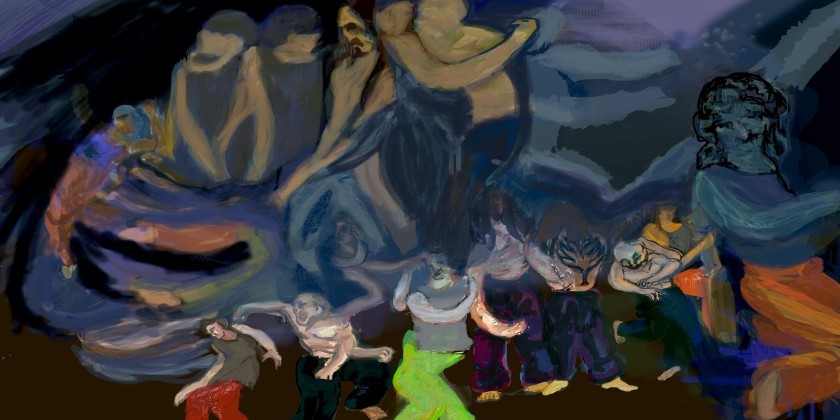AUDIENCE REVIEW: On Coming Through (and doing so vibrantly)

Company:
Jessie Young & Jordan Demetrius Lloyd
Performance Date:
August 10 & 11, 2018
Freeform Review:
It was hot as hell. At Brooklyn Studios for Dance on the weekend of August 10, Jessie Young and Jordan Demetrius Lloyd presented “Come Through”, a shared evening of sharing work, experiences, and space. The heat lined the walls and invited those who had come through to come together--- to talk, to reconnect, to linger between the seats carefully placed on a staggered diagonal across the studio---to warm up the labyrinth of space with and for each other. When the lights dimmed it was as if the fluttering of the audience’s neon, sparkly, homemade fans (found on our seats) beckoned the performance to begin, making visible the inherent layer of heat found in this shared studio and manifesting it in motion, our motion, to meet theirs.
***
Jessie Young’s weather began the program, a work enacted through duets and presented in three parts, standing as one part of a larger project that will culminate in an evening- length show at Brooklyn Studios for Dance in February 2019. The work exudes magic, sensationalizes the electrically personal and mysteriously folkloric identity of relationships through physical embodiment. It is rooted in the visual and auditory activation of the space and the senses.
weather begins with a sweep, the dancers canvassing the space as if treading water and using their arms to keep them afloat. We immediately see a billowing intricacy of weaving and threading. They rebound and rocket through each crevice, wake it up, wake us up, show us what is above/between/below, with an unrelenting and harshly compelling directness of physicality and gaze. The blusteringly translucent soundscore siphons through their bodies and overflows into a quiet hum, tugging at and polarizing the space, making the activation inherently physical with a residual of sound, tangibly connecting us to the performance. Through this breeze of movement we access the first wave of seeing and sensing, enlivening the entire entity of the space in front of us, visually and physically.
This treading streams into a neon abruptness of ease as a second duet (of Jessie Young and Jessica Pretty) enters and takes up position at the bottom of the diagonal, the diagonal that streaks the space and separates the audience. Planted at the apex of two mirrors, their reflections shimmer with the brightness of their costumes, illuminating the bold sparkle and magic of their bodies and their beings. They buzz with the vibrancy of their relationship, stirring their sinuous and gooey movement by emphasizing the playful back and forth of the sound 'ch' as a means for conversation, foregrounding the audible and etching their bodies, physically and otherwise, into the mirrored architecture of slivered space. They move away, leaving their imprint, increasing their vocals, regaining and relinquishing control through a game of tag, a pardon of play, persuading the rumble of the soundscore to evolve, effortlessly, magically, into Prince’s “Little Red Corvette”. A duet turned soundscore turned dance party. In this moment we are privy to the second wave of seeing and sensing. Prickling the edges of our viewing bodies with sound, we recognize the act of occupancy as not purely visual or physical. We recognize our occupancy as an act of listening.
This momentum slowly crackles, drawing us once more away from the diagonal, fizzling weather into Part 3. The duet, which exchanges Jessica Pretty for Jasmine Hearn, now lives in disparate sections of the space: Hearn on the balcony and Young on the raised stage directly across. The audience sits between, swallowed, framed, by their experimentations with sound. Their sheer presence, manifested vocally, overtakes the vacuous swath of audience. For the first time, we are an audience hollow of movement. In this glorious moment of vocal indulgence, the undercurrent of this work becomes apparent, as does Young’s knack for positing motion in different forms: a brilliant repositioning of what it means to fill, an ongoing entanglement of the space of sound with bodies and movement and the permeance of all that exists between. As they navigate this porous capturing of being together, the entire space teems with the neon buzz and treading memory of the previously created utopic world of physical and auditory transformation. The final duet descends back to the audience’s level and siphons the energy that buzzes between them: fluttering, deepening, and finding space, in all forms, between and with --- engulfing us fully in the bold and mystical quality of Young’s dancing worlds.
***
Jordan Demetrius Lloyd’s work, NEIGHBORS, comes after intermission---a time allotted to a DIY space remodel---positioning viewers on the two far ends of the studio, creating a long stretch of “stage” framed by the audience, the two doors, and the adjacent white wall. We are dropped into the piece with a combustion of rhythmic cohesion, a prelude to the movement itself. It is not yet time for us to see the bodies, to see the rhythm makers. There is a moment of silence before the piece visually begins, tensing the space before springing the five dancers, unrelentingly, through the door. As we watch this orbiting spatial navigation we settle into the winding manipulation of time and movement, the dotting and checking and painting of the rhythmic intentionality through their bodies on the space, like streaks of paint brushed and echoed in an effort to create a semblance of familiarity, of knowing. They settle into a repetition, like a loping punctuation that feels finite but never quite arrives. The energy of the five bodies and the simple dissonance in color of costume powers the momentum forward. As it unfolds we can’t help but feel this is order, this is rhythm, visualized and physically manifested, through color, movement, and sound.
Again we are struck by rhythm, but this time we can see it being created, can see the effect it has on the moving body. The rhythm is the movement, the binding force that intertwines the spatial relationships. A chant, physicalized. In this moment they come together. The quiet that follows is full, replanting silence as a means for moving, for connecting, hopscotching through collisions, untangling and unraveling, occasionally slamming into walls--- a rhythmic agenda concentrated in space. The movers are continually finding opportunities for settling, for finding each other, for detailing each other from there. The linearity of one body underscores the squiggles of another. They detach. They attach. They detach again. The relationships are dependent on space, on the bounds set up by and for each other. They enlighten the crevices made for watching as individuals and pairs streak through a swath of openness, stamping a line on the floor and coloring it through different variations of bodies and phrases.
Lloyd’s work makes us question what is present in the room, makes us wonder what it is we latch onto and why we see what we see. How others become the details that allow us to see more fully, allow us to see more clearly. We watch relationships build and unfold, watch colors blur as ensembles interchange into partnerships and individuals. Rhythmic identities rub up against spatial and physical manifestations of moving bodies, requiring patience, illustrating surrender, bringing us closer. We are desiring more, seeking clarity, visualizing complexity. What remains is a residue of color, a residual of rhythm, a lingering shadow swept up and recreated by the brushes of movement.
***
The work presented in this show felt like summer, felt like the warm, sticky heat of the August air: intentional and consuming. Young and Lloyd created a place for painting the space, for deepening the experience, for activating our senses, for coming together. They invited us to boldly, colorfully, and thoughtfully come through, and to do so vibrantly.
Author:
Phoebe Ballard
Website:
https://www.pballardmoves.com/
Photo Credit:
Whitney Browne Photography











